3D printing with PLA vs. PETG: What's the difference?
Learn the benefits of PLA and PETG, when you should use one instead of the other, post-processing techniques that work for both materials, and more.
Read articleYou’ve come to the right place. Hubs is now Protolabs Network.
The same broad capabilities, exceptional quality and competitive pricing under a new brand.






EN
Want to learn more about chemically resistant parts? Find out about common chemical-resistant materials, their advantages, disadvantages, and industrial applications.
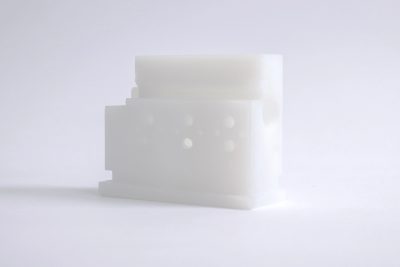
A material's chemical resistance refers to its ability to withstand exposure to harsh chemicals or solvents. Chemically resistant materials don’t typically require surface treatments or post-processing to achieve their properties as the polymers themselves exhibit chemical resistance.
Chemical-resistant parts have long been important in manufacturing and packaging. They’re also one of the major advantages that plastic has over metal. In the absence of chemical resistance, parts may dissolve, become misshapen, or otherwise weaken when introduced to chemicals. This will result in parts or tools that are potentially unusable or unsafe, costing organizations time and money to replace.
Take a look at the industries in which chemical-resistant parts are often used, commonly used chemical-resistant materials, and a few tips on using them.
Chemical-resistant parts are used in a wide variety of industries for a wide variety of applications. Essentially any part that comes into contact with a potentially harsh chemical (whether it’s a solid, liquid, or gas) will need to show at least some chemical resistance. The automotive industry, for example, relies on chemically resistant parts in production plants, where oil, lubricants, and other chemicals are often present.
These materials exhibit excellent chemical resistance along with other properties.
PP –semi-rigid, translucent, heat-resistant
PVDF – abrasion-resistant, UV-resistant, thermally stable
Nylon –strong, elastic, resilient, moisture-resistant
PA –wear-resistant, thermally stable, strong, hard
The following materials exhibit good chemical resistance along with other properties.
PC – strong, stiff, hard, tough
TPU – ductile, abrasion-resistant, transparent, elastic
PETG –hard, impact-resistant, ductile, transparent
ABS –low melting point, impact-resistant, high tensile strength
Considerations for using or creating chemical-resistant parts:
Degrees of chemical resistance. A part can be resistant, partially resistant, or non-resistant to chemicals. If partially chemical-resistant, a part or tool may be able to withstand chemicals for short periods of time but will deteriorate if exposed for longer durations.
External factors. Temperature, UV exposure, moisture levels, and other environmental forces will have an effect on your part, no matter its degree of chemical resistance. Keep this in mind when selecting the right material for the job at hand.
Learn about the factors that influence a material’s chemical resistance, applications for chemical-resistant parts, and more.
A material’s chemical resistance is influenced by:
Surface area of exposure. The greater the exposure of a part’s surface, the faster and more extensively it will degrade over time.
Temperature. Typically, the higher the temperature to which a chemical-resistant material is exposed, the faster it degrades.
Chemical strength. The higher the chemical concentration, the harder a material has to work to resist it. This will result in faster degradation.
Length of exposure. A chemical-resistant part exposed to a chemical for a long period of time will degrade faster than one exposed to the same chemical for a shorter length of time.
Mechanical stress. If a chemical-resistant part is put to work in a stressful, hardworking environment, any resulting change at a molecular-level may lower its chemical-resistant properties.
Absorption. A material that absorbs moisture will more readily absorb the chemicals to which it is exposed, resulting in its weakening (either by softening or hardening).
The factors listed above all play major roles in the efficacy of a material’s chemical resistance. This means chemical resistance does indeed depend on the application. Before selecting a material, be sure to understand all of its properties.
Follow these tips and note some design limitations for chemically resistant materials.
Part strength and design. A part with a complex geometry or a greater surface area exposed to chemicals will degrade faster than a part with a simpler design and a smaller area of exposure. Reinforcing areas of the part where exposure is high can help with its longevity.
Choose the right material. Not all materials categorized as chemically resistant are resistant to the same chemicals. This may seem obvious, but it is nevertheless important to consider the type of chemicals or solvents to which your part will be exposed. PVDF, for example, will be unaffected by strong acids and oxidants, while ABS holds up better against alcohols. PP, while resistant to most chemicals, cannot withstand exposure to acetone – to which Nylon is resistant.
Find out more about materials for manufacturing and how to choose the right one for your design.
To produce a part using chemically resistant materials, upload a CAD file for an instant quote and automatic DFM analysis. For further information or recommendations on materials with the right properties for your project, contact networksales@protolabs.com for assistance.

Chemical-resistant parts are able to withstand prolonged exposure to harsh chemicals in industrial environments.
Chemical-resistant parts may not exhibit resistance to factors such as high temperatures or UV light.
Chemical-resistant parts are used in all industries, but especially those in which oils, lubricants, solvents, or other chemicals are often present in manufacturing, such as automotive or aerospace.
Chemical-resistant parts aren’t necessarily expensive, but you can potentially cut costs by selecting the right material for the job at hand, avoiding the need for expensive iterations or replacements. Upload a part to view prices instantly.
The length of time it takes to produce chemical-resistant parts largely depends on the complexity and size of their design. The larger and more complex, the longer the production time.

Learn the benefits of PLA and PETG, when you should use one instead of the other, post-processing techniques that work for both materials, and more.
Read article
Learn the benefits of PLA and PLA+, when you should use one instead of the other, post-processing techniques that work for both materials, and more
Read article
Nylon, also known as polyamide (PA) is a synthetic polymer with high tensile strength, excellent resistance to wear and abrasion, and a low coefficient of friction. Here’s how it’s used in manufacturing and engineering applications.
Read article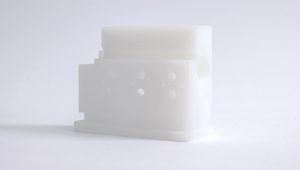
Want to learn more about chemically resistant parts? Find out about common chemical-resistant materials, their advantages, disadvantages, and industrial applications.
Read article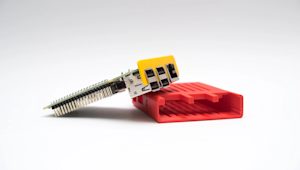
Polylactic acid, also known as PLA, is a thermoplastic material commonly used in additive manufacturing. It is one of the most commonly used materials in 3D printing, and can be used to create a wide range of parts, packaging, and prototypes for the medical, food, cosmetics, and textile industries, among others.
Read article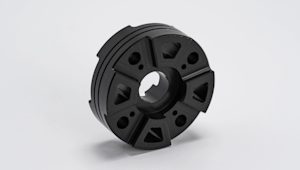
What is Delrin and why is it unique among the many manufacturing materials available? Delrin, or POM-H (homopolymer acetal), is used in CNC machining, 3D printing and injection molding to create durable, precise components. This article explores Delrin’s properties and how to get the most out of the material.
Read article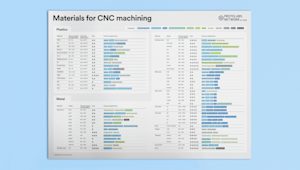
What’s the best material for machining your parts? Check out this side-by-side comparison of the strength, price and application for CNC plastics and metals (in a handy, printable poster).
Read article
This comprehensive guide compares the 25 most common materials used in CNC machining and helps you choose the right one for your application.
Read article
What are the different materials available for SLA 3D printing? This article compares the main printing resins, including standard, tough, durable, heat resistant, rubber-like, dental and castable, by material properties. Find the best material option for your application.
Read article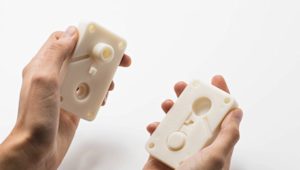
We compare critically two industrial 3D printing materials used for low-run injection mold manufacturing.
Read article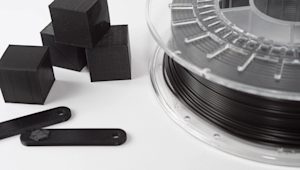
What’s the ideal material to use when 3D printing parts with FDM? This article compares the most common FDM 3D printing filaments, including PLA, ABS, PET, Nylon, TPU (Flexible) and PC, by their material properties to help you find the best option for your application.
Read article
PLA and ABS are two essential materials for 3D printing with FDM. They are also two of the most popular materials on our platform. This comparison will help you choose which material to use for your 3D-printed custom parts.
Read article
Learn the benefits of PLA and PETG, when you should use one instead of the other, post-processing techniques that work for both materials, and more.
Read article
Learn the benefits of PLA and PLA+, when you should use one instead of the other, post-processing techniques that work for both materials, and more
Read article
Nylon, also known as polyamide (PA) is a synthetic polymer with high tensile strength, excellent resistance to wear and abrasion, and a low coefficient of friction. Here’s how it’s used in manufacturing and engineering applications.
Read article
Want to learn more about chemically resistant parts? Find out about common chemical-resistant materials, their advantages, disadvantages, and industrial applications.
Read article
Polylactic acid, also known as PLA, is a thermoplastic material commonly used in additive manufacturing. It is one of the most commonly used materials in 3D printing, and can be used to create a wide range of parts, packaging, and prototypes for the medical, food, cosmetics, and textile industries, among others.
Read article
What is Delrin and why is it unique among the many manufacturing materials available? Delrin, or POM-H (homopolymer acetal), is used in CNC machining, 3D printing and injection molding to create durable, precise components. This article explores Delrin’s properties and how to get the most out of the material.
Read article
What’s the best material for machining your parts? Check out this side-by-side comparison of the strength, price and application for CNC plastics and metals (in a handy, printable poster).
Read article
This comprehensive guide compares the 25 most common materials used in CNC machining and helps you choose the right one for your application.
Read article
What are the different materials available for SLA 3D printing? This article compares the main printing resins, including standard, tough, durable, heat resistant, rubber-like, dental and castable, by material properties. Find the best material option for your application.
Read article
We compare critically two industrial 3D printing materials used for low-run injection mold manufacturing.
Read article
What’s the ideal material to use when 3D printing parts with FDM? This article compares the most common FDM 3D printing filaments, including PLA, ABS, PET, Nylon, TPU (Flexible) and PC, by their material properties to help you find the best option for your application.
Read article
PLA and ABS are two essential materials for 3D printing with FDM. They are also two of the most popular materials on our platform. This comparison will help you choose which material to use for your 3D-printed custom parts.
Read articleShow more
Show less